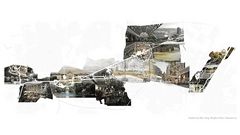At the beginning of the 18th century Elector Max II. Emmanuel had the Nymphenburg-Biedersteiner Canal constructed as part of Baroque urban design. Waterways and roads were used equally as means of urban planning — the main road connection to the city of Munich was planned in a south-easterly direction equivalent to the north-eastern canal. While in the further urban development roads and traffic axes for motorised traffic were in the foreground, the canal has been neglected as an open space structure for long time. Today the canal lies within the city, always changing its face: from the baroque canal to the meandering Olympic lake of 1972, from the Petuelpark, completed in 2004, to the Schwabinger See from the 1980s. As a city crossing open space structure, it is of central importance for humans, animals and plants. How can their concerns be reconciled?
The aim of the Master project "CANALETTO — Open Spaces Along the Nymphenburg-Biedersteiner Canal" is to capture the open space characters of the Nymphenburg-Biedersteiner Canal in its entire extent and to depict hidden structu-res and qualities. On this basis, guidelines for further development are developed collectively. On the basis of design drafts and proposals for activation, a critical analysis of the urban development, open space planning and ecological structure is carried out. The inclusion of the interests of heritage protection and nature conservation is of outstanding importance here. The various research topics have been edited as part of the integrated discipline.
The students' designs and concepts were supervised by Prof. Regine Keller (Chair of Landscape Architecture and Public Space), Guest Professor Silvia Benedito (GSD Harvard), Tanja Gallenmüller (Calwey), Johann-Christian Hannemann, and Felix Lüdicke.
The individual student projects will be presented at the vernissage of the exhibition on February 7, 2019.
The projects are shown at the matriculation hall (TUM main campus) until February 14, 2019.
